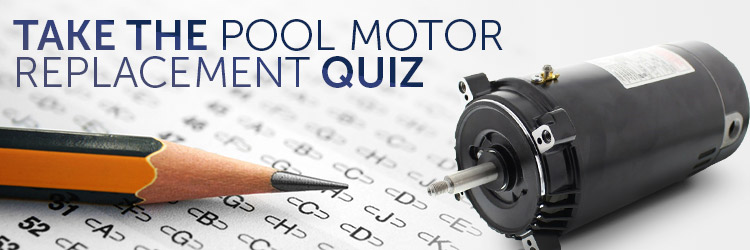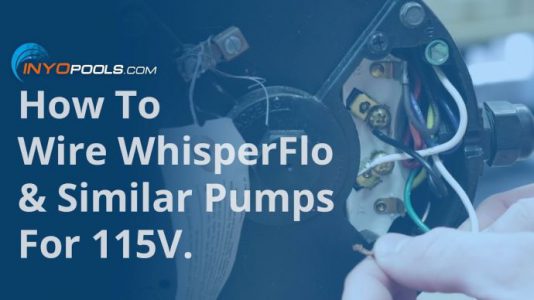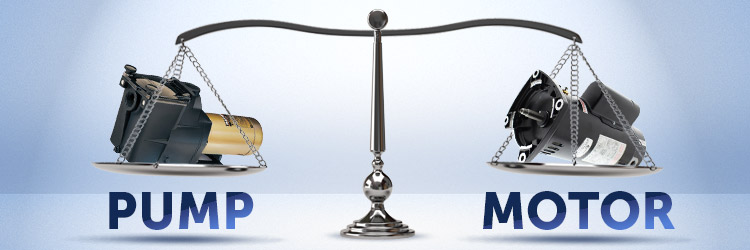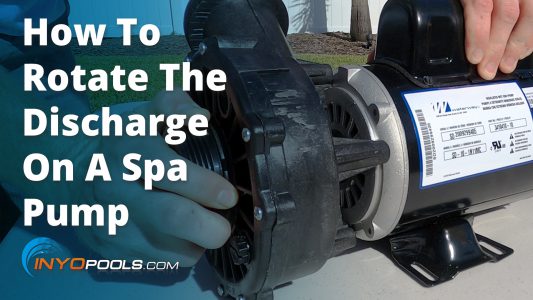If your pump motor is on its last legs you may be pondering doing the repairs yourself. Do you think you’re up for the challenge? Take our test and find out…
Do you like to save money? Yes or No
If the answer is:
Yes – Well, proceed to the next question because we have got a lot to cover. Maintaining and servicing your own pool and spa equipment can help you save a pretty penny over the lifetime of a pool. Think about the cost of a simple service call before parts and labor are even added. It hurts a little doesn’t it? Your wallet just flinched at the memories, I swear. The sad part is that pool owners do not realize how easy the replacing a pool pump motor can be.
No – Excuse me, Daddy Warbucks I apologize for making you read this. Or more likely, I apologize for making your butler read this to you. No need to read further, test failed.
Be honest with me and yourself – on a scale of 1-10 rate how mechanically inclined you are?:
< 3 – I would suggest hiring a professional for you and your pump’s safety. Replacing a motor is not hard, but it definitely is not easy. If a novice starts flinging bolts, wrenches and hot wires around, that is a recipe for disaster and can cause even higher repair bills.
4 – 7 – Right in the middle, also called the ‘Mama Bear’ zone. A person who honestly assesses themselves in this range can handle the task given the proper instruction. You may not know how to do the task intuitively, but can be walked through it and not mess it up. If you are in this range, be steadfast in the knowledge you are in the majority of people who own pools. And this also means that more than likely you can replace a pool pump motor with a little bit of homework.
8-10 – Looks like we got a regular Bob Vila over here. If you are in this group, you are no stranger to dirty or dangerous work. A member of this elite grouping should be proficient in electrical wiring, electrical testing, plumbing and the basic mechanic fundamentals.
Do you know the difference between the pump and the motor?
The veteran pool owners reading this may scoff at the question, but a new pool owner is often confused by these terms. For the uninitiated, a pool pump is made of two separate halves; the wet end and the motor.
The wet end is the front end of the pump, sometimes referred as the housing. This vessel contains the strainer basket, lid, drive train assembly, and gaskets. Some would compare it to the hull of the ship because it is where all the parts of the pump come together as one.
Then, we have the motor which is the cylindrical 25 pound behemoth that gets bolted to the housing. The motor is connected to the pump’s seal plate which acts as a flange that we can then secure to the housing of the pump.
Friendly Reminder: When replacing a motor, always replace the shaft seal with it. This seal wraps around the shaft of the motor behind the impeller to prevent water from seeping into the electric components. An old shaft seal can cause a leak in your brand new motor making it nothing more than a paperweight in a few months. Think of a shaft seal as a $15 dollar insurance policy for your motor.
Do you know which replacement motor you need?
This can be solved with a walk out to your pump pad to read your motor label. Motors have several identifying numbers on their labels to aid in tracking down a replacement. The ID numbers are termed the Part, Catalog or Model number. Once that number is found on the label, it can be input into Inyo’s search engine to quickly find a replacement.
- Part Number – This number is usually formatted using the digit pattern of one-six-two, for example 7-184456-20. Sometimes the full part number is not searchable so try using only the middle six digits
- Catalog Number – These are the shortest of the ID numbers and follow the format of the letter B followed by three or four numbers; for example B854 or B2842. If you attempt to search the number B842 and the result brings back the B2842, no worries – it is the same motor. That extra 2 serves no real purpose in differentiating the motors.
- Model Number – The longest and most complicated the model number uses a mix of numbers and letters. An example would be C48K2N143A4. A model number usually begins with a C48 or a K48 and is followed by a sequence of numbers and letters
If you are the curious type, swing by our How to read a Motor Label guide for further instruction.
Do you know at which voltage your pool pump motor operates?
As with anything electric, pool motors require a specific voltage for them to function properly. If the correct voltage is not applied then it will either sit silent, hum, or create a fabulous and expensive fireworks show. Residential pool pump motors come in three major voltage categories 115, 230, or 115/230 (dual voltage).
If your plan is to research and replace the pump motor yourself, one of the first things to check is the current motor’s voltage setting. This task is completed by testing the wire leads with a voltmeter. If there is not one on hand, a voltmeter can be purchased or possibly rented from a hardware shop.
Most motors we sell are of the dual voltage variety which can be wired for 115 or 230. But the motors are shipped from the factory set to 230 volts. If your application requires the motor to be set for 115, the voltage knob or jumper switch needs to set accordingly. The motor is set to 230 from the factory to prevent damage in case a wiring snafu occurs. If I had a nickel for every time a caller stated the motor they received was defective because it would not turn on, but in actuality they had forgotten to switch the voltage knob to 115, I’d be writing this blog on my own private beach.
If you want to do further reading on motor wiring, help yourself to our step by step guide: How To Wire A Pool Pump.
Can you follow instruction? Yes or No
If the answer is:
Yes – You are in luck, because I have a handy dandy guide and video to help you get that pump up and running: How To Replace the Motor on Your Pool Pump.
Stop reading this, go forth and be merry.
No – Then, I’m not sure how you sat through this test. Goodbye.











Thank you Matthew for writing this. Every little bit helps. I am ordering my motor and kit from you folks today. And have started to learn the videos while it is in shipment.
I am a pool newbie of 3 months now. We have had literally 6 pool people take money, rip us off and lie to us. One even broke the impeller on another pump then hi tailed it out. We had to pay another company to fix it for several hundred dollars. This motor I am determined to put in myself. I just hope the plastic wire casing nut does not break as the other one did. And the pool company just left it that way. Really bad here in Florida. You have to just LEARN yourself! Which I am determined to do.j
Aloha Antoinette